Incense Cup
Incense Cup is in Prehistoric Artefacts.
Section I Tumuli 1787. Towards the north-east end of Stanton Moor is a small Druid circle, inclosed with a vallum of earth and stones, not raised above two feet; within this at the west end was a little barrow [Map]; opened about the year 1787, by Mr. Rooke; this barrow was about six feet in diameter, and but slightly higher than the surrounding field. The Major here found three large urns of coarse clay, placed in a row, about eight inches from each other. They rested upon stones a little below the natural soil, within twelve or fourteen inches of the top of the barrow.
Seing so near the surface the heavy rains and the roots of fern and gorse which had so penetrated the urns, made it difficult to move them without their falling to pieces; in taking out of one of them the ashes and bones which it contained, the Major found at the bottom, a smaller urn, also full of burned bones, covered with a piece of clay of a circular form.
In 1799 Mr. White Watson, of Bakewell, procured several urns from tumuli, upon Stanton Moor, one of which with an incense cup found at the same place is here engraved. From the information of the person employed, it appears that three were frequently found in one barrow, arranged in a triangular form. Several other barrows were opened upon Stanton Moor by the Rev. Bache Thornhill, in which were discovered only such interments as had undergone cremation, and in most cases the ashes had been gathered together and placed within urns; the remains of three varieties of these vessels, with their contents, were presented by William Pole Thornhill, Esq., of Stanton, to the writer. Amongst the calcined bones were two pins, one of bone, the other of bronze, a few pieces of flint, and a large pebble with a vitrified surface resulting from the strong degree of heat to which in common with the other articles, it had been exposed.
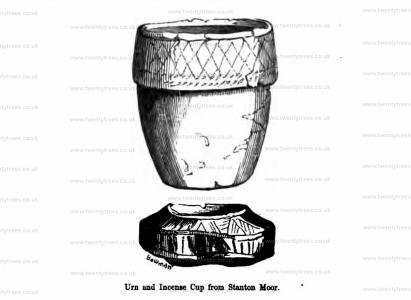
Colt Hoare 1812. No. 131 [Map] had been opened by the neighbouring farmers. In this barrow we found, in a deep cist, an unusually large quantity of burned bones, and with them two drinking cups, two incense cups, and two brass pins. One of the incense cups was preserved entire, and is engraved of the original size in TUMULUS Plate XXIV. The quantity of bones, and the duplicate articles would induce me to suppose that this mound was raised over the relicks of two persons.
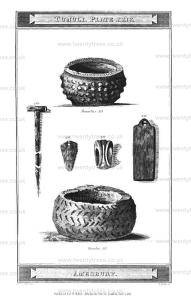
Colt Hoare 1812. No. 133 [Map] is a very high barrow: but the plough has made considerable encroachments round its base. It contained within a deep cist, a pile of burned bones, and a very beautiful and perfect grape cup, which is engraved in the same plate with the aforementioned cup.
Section I Tumuli 1825. The only barrow yet discovered in a low situation in the neighbourhood of Middleton is placed in a meadow called Larks Lowe [Map], and near the rivulet called the Bradford; this tumulus was opened on the 20th of May 1825 when the cist was found to be constructed of large flat stones placed edge-ways with similar ones serving for the cover; it contained the decayed fragments of a human skeleton. On the eastern side of the barrow was found an urn of coarse earthy full of calcined bones and dry mould, the top protected by a flat piece of lime-stone, upon which was placed a small, shallow, earthen vessel very firmly baked, (of the kind denominated by Sir Richard Hoare (age 66) "incense cups"), a pin of bronze, two and a quarter inches long; several animal teeth and bones, amongst them a horse's tooth, a circular pebble, and a stone of peculiar shape; the large urn was of so friable a nature, that it probably had no other baking than what it received in the funeral fire, from this cause it was found impracticable to preserve it entire. June 19, 1826, it was thought advisable to reopen the very interesting barrow [Map] on Garratt Piece, Middleton, which was opened by Dr. Pegge in 1788, and described in the Archæologia, vol. ix, page 189; in it were found animal bones, one of which was calcined; a portion of the lower branch of an antler of the red deer, six inches in length, which had been tooled at the root by a sharp instrument; also some rats' bones. (See a subsequent examination of this barrow.)
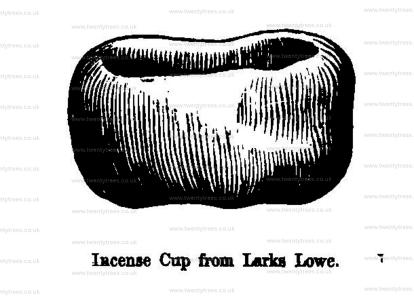
Derbyshire Archaeological Journal Volume 30 1908 Page 155. May 20th, 1825. With somewhat better success we opened a tumulus not far from the village of Middleton, and on the low ground near the river Bradford1. The country people knew it by the name of Larks low [Map]. About the centre of the mount we discovered a cist formed of large stones set edgeways at the sides and ends with similar ones serving for a cover. It contained the decayed fragments of a human skeleton. On the Eastem side of the barrow, after removing a flat stone we discovered an earihern lamp2 (Fig. 1 in annexed plate) which I should consider Roman, and which was placed on the top of a large urn full of burnt bones and ashes. The urn being composed of clay, which had only been baked in the sun, fell into small pieces on the slightest touch, so that no part of it could be preserved. Fig. 3 presents the manner in which it was ornamented by zig-zag scratches, and from a segment of the circle measured on the spot it appears to have been 7 inches diameter on the rim and 4¼ inches diameter at bottom. Its general shape seemed to be like Fig. 4.3 - The lamp which had been well baked, and is in great preservation was 3¾ inches diameter and 2 inches high. Fragments of human bones, along with the teeth and bones of horses and other animals (among which the water rat was, as usual, conspicuous,) were scattered throughout the mount.
A copper pin, Fig 2.4. rather more than 2 inches in length, which had previously served as a fastening for the dress, was also found.
These barrows are situate in this manor of Middleton by Youlgreave, belonging to Thomas Bateman Esquire5, and were opened under the superintendence of Mr W Bateman and myself. - l am decidedly of opinion that they are all Roman or Romanized British6.
Note 1. lbid., p. 33.
Note 2. A so-called "Incense cup."
Note 3. This is hardly likely to be a correct restoration of the cinerary urn.
Note 4. Not copper, but bronze, Evidently an awl, not a pin.
Note 5. Father of William Bateman.
Note 6. This, of course, is a wrong surmise. They are all of the Bronze Age.
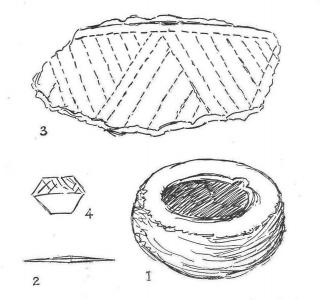
Section I Tumuli 1830. About the year 1830 a barrow upon the East Moor, near Baslow, called Stone Lowe [Map], was accidentally opened by the farmer in whose stackyard it stood. In the centre he found two large urns, both neatly ornamented, and both containing calcined bones and flints. Inside one of them was a small incense cup, with two perforations through one side. This being fortunately preserved, we are enabled to give a cut of it.
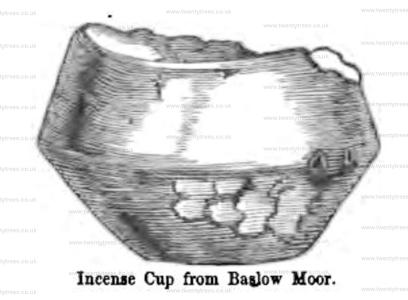
Section I Tumuli 1843. The first tumulus opened this season was situate upon the Meadow-place Farm, near Yolgrave, and is generally known as Bee Lowe [Map]; it was decided upon to open it on the 16th of June, when it was found to be impossible to excavate it in a proper manner, owing to the trees growing upon the sides; therefore the only method of examining it was by sinking a hole down the centre of the mound, which consisted of loose earth and stones, amongst which a profusion of rats' bones was met with. In the course of this excavation the broken fragments of a human skeleton were turned up, which made it evident that one interment at least had been disturbed at some former period. Amongst these bones were found a small arrow-head of flint, elegantly formed, two rude instruments of the same material, and about half a dozen horse's teeth. On reaching the native soil, which was about four feet from the top of the barrow, the primary deposit was found, consisting of burnt bones, amongst which was part of a bone pin, also calcined; and near to the same place lay some fragments of a well-baked clay urn, very tastefully ornamented with a chevron pattern, and which had been of the form of vessel designated "drinking cups" by Sir Richard Hoare, by which name they will be distinguished in the subsequent parts of this work, as a simple way of expressing their difference from the sepulchral urns and incense cups, although it is by no means certain that they were made use of for the purpose implied by the words "drinking cup."
Section I Tumuli 1843. The 30th of June 1843 was occupied in examining the middle part of a large barrow on Brassington Moor, usually called Galley Lowe [Map], but formerly written Callidge Lowe, which is probably more correct. About two feet from the surface were found a few human bones mixed with rats' bones and horses' teeth; amongst these bones (which had been disturbed by a labourer digging in search of treasure) the following highly interesting and valuable articles were discovered: several pieces of iron, some in the form of rivets, others quite shapeless, having been broken on the occasion above referred to, two arrow-heads of the same metal, a piece of coarse sandstone, which was rubbed into the form of a whetstone; an ivory pin or bodkin, of very neat execution; the fragments of a large urn of well-baked earthenware, which was glazed in the interior for about an inch above the bottom; two beads, one of green glass, the other of white enamel, with a coil of blue running through it, and fourteen beautiful pendant ornaments of pure, gold, eleven of which are encircled by settings of large and brilliantly coloured garnets, two are of gold without setting, and the remaining one is of gold wire twisted in a spiral manner, from the centre towards each extremity (a gold loop of identical pattern is affixed to a barbaric copy of a gold coin of Honorius in the writer's possession); they have evidently been intended to form one ornament only, most probably a necklace, for which use their form peculiarly adapts them. It will here not be out of place to borrow some quotations relative to a remarkable superstition connected with glass beads similar to those discovered in Galley Lowe, particularly the one having "two circular lines of opaque sky-blue and white," which seem to represent a serpent entwined round a centre, which is perforated. "This was certainly one of the Glain Neidyr of the Britons, derived from glain, which is pure and holy, and neidyr, a snake. Under the word glain, Mr. Owen, in his Welsh Dictionary, has given the following article: "The Nair Glain, transparent stones, or adder stones, were worn by the different orders of the Bards, each exhibiting its appropriate colour. There is no certainty that they were worn from superstition originally; perhaps that was the circumstance which gave rise to it. Whatever might have been the cause, the notion of their rare virtues was universal in all places where the Bardic religion was taught."
These beads are thus noticed by Bishop Gibson, in his improved edition of Camden's Britannia: "In most parts of Wales, and throughout all Scotland, and in Cornwall, we find it a common opinion of the vulgar, that about Midsummer-eve (though in the time they do not all agree) it is usual for snakes to meet in companies, and that by joining heads together and hissing, a kind of bubble is formed, like a ring, about the head of one of them, which the rest, by continual hissing, blow on, until it comes off at the tail, when it immediately hardens, and resembles a glass ring, which whoever finds shall prosper in all his undertakings: the rings they supposed to be thus generated are called gleinen nadroeth, namely, gemma anguinum. They are small glass annulets, commonly about half as wide as our finger-rings, but much thicker, of a green colour usually, though some of them are blue, and others curiously waved with blue, red, and white.'' There seems to be some connexion between the glain neidyr of the Britons and the ovum anguinnm, mentioned by Pliny as being held in veneration by the Druids of Gaul and to the formation of which he gives nearly the same origin. They were probably worn as a mark of distinction, and suspended round the neck as the perforations are not large enough to admit the finger. A large portion of this barrow still remaining untouched on the south-east side, which was but little elevated above the natural soil, yet extending farther from the centre, it offered a larger area, in which interments were more likely to be found than any other part of the tumulus, it was decided on resuming the search on the 3d of July, 1843, by digging from the outside until the former excavation in the centre was reached. In carrying out this design the following interments were discovered, all of which seem to pertain to a much more remote era than the interment whose discovery has been before recorded. First, the skeleton of a child, in a state of great decay; a little farther on a lengthy skeleton, the femur of which measures nineteen and a half inches, with a rudely ornamented urn of coarse clay deposited near the head; a small article of ivory, perforated with six holes, as though for the purpose of being sewn into some article of dress or ornament (a larger one of the same kind was found in a barrow at Gristhorpe, near Scarborough, in 1832); a small arrow-head of gray flint, a piece of iron-stone, and a piece of stag's horn, artificially pointed at the thicker end, were found in the immediate neighbourhood of the urn. Between this skeleton and the centre of the barrow four more skeletons were exhumed, two of which were of young persons; there was no mode of arrangement perceptible in the positions of the bodies, excepting that the heads seemed to lie nearest to the urn before mentioned. Amongst the bones of these four skeletons a small rude incense cup was found, which is of rather unusual form, being perforated with two holes on each side, opposite each other.
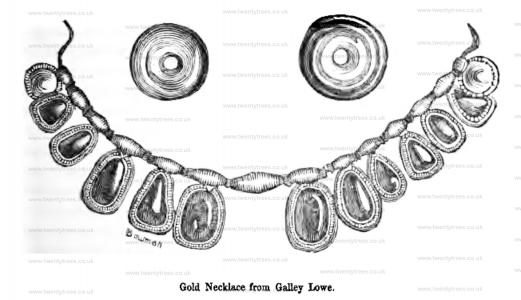
Section I Tumuli 1843. July 14th, 1843, one of the most interesting barrows ever examined in this vicinity was opened. It is situated upon a ridge of high land, near the village of Biggin, which goes by the name of the "Liffs [Map]," the barrow itself having no specific name: the mound had been sadly mutilated, at least one third of it having been removed; notwithstanding this the truth of Sir Richard Hoare's maxim, "fronta nulla fides," was agreeably exemplified. That hemisphere of the circle which still remained the most perfect was selected as the place where to commence operations: on reaching the thickest part of the circle, which, owing to the depression usual in the middle of most barrows, would be about two yards from the centre, a few human bones, horses' teeth, various animal bones, and two small pieces of a very thick and coarse urn, were found; but not until penetrating to the heart of the barrow was the principal interment discovered. In that situation an octagonal cist was erected of the usual material, namely, thin flat lime-stones, which are admirably adapted for the purpose; this vault was about half filled with stiff clay, imbedded in which lay a fine human skeleton, whose knees were drawn up, according to a general custom, prevalent in the most remote ages. The extreme antiquity of this interment is demonstrated by the simple form and material of the weapons and tools which were, with one exception, deposited in a cluster behind the shoulders of this early denizen of the Derbyshire moors. The skull, which is fine and intellectual, lay on the left side so as to look towards the west, and in the angle formed by the contraction of the knees, was placed a hammer-head ingeniously constructed out of the lower part of the horn of a noble red deer; one end of this instrument is rounded and polished, the other is cut into a diamond pattern, somewhat similar to the wafer stamps used by attorneys. The articles before alluded to as being placed near the shoulders were of a very miscellaneous character, and highly interesting; as showing, after a lapse of several thousand years, that the savage Briton reposing in this cairn had cultivated the art of making war amongst the inhabitants of the forest, in preference to molesting his fellow-savages; as almost the first observed articles were a pair of enormous tusks of the wild boar, the trophies of some, perhaps his last, sylvan triumph; next came two arrow-heads of flint, delicately chipped, and of unusual form; two flint celts or chisels, beautifully chipped and polished at the cutting edges; two spear-heads of the same material; two flint knives polished on the edge, one of them serrated on the back, in order to serve as a saw; and numerous other pieces of flints of indescribable form and use, which, together with all the flint instruments enumerated above, seem to have undergone a partial calcination being gray tinted with various shades of blue and pink; with these utensils were found three pieces of red ochre, the rouge of these unsophisticated huntsmen which, even now, on being wetted imparts a bright red colour to the skin, which is by no means easy to discharge. Upon the summit of the little heap, formed by this accumulation of relics, lay a small drinking or incense cup of novel and unprecedented shape, which was unfortunately broken and crushed, but has been since restored. The absence of instruments of metal in this and other barrows should be borne in mind; it is commented on in another part of this work.
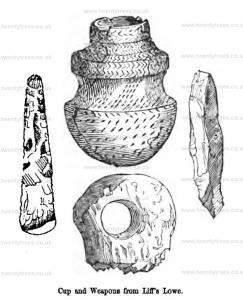
Section I Tumuli 1843. Saturday the 9th of September 1843 a remarkable barrow at Cross Lowe [Map], near Parwich [Map], was opened. It had every appearance of being a small tumulus about three feet in height; but was found to have been constructed above a depression in the rock, about two feet deep, thus increasing the height of the artificial structure to five feet. It was thought that the most effectual way of opening this barrow was to begin a cutting on both the north and south sides, and thus to meet in the middle; this was done with the following interesting results: on the north side a secondary deposit was founds about eighteen inches below the surface of the mound; it was the skeleton of a young person, and was accompanied by a small urn, much ornamented, and a bone pin. On the south side the floor was found to decline rapidly towards the centre, on approaching which a very rude cist was discovered, formed of stones set edgeways upon the solid rock, which supplied the bottom of the cist, on which lay a large and strong human skeleton, with the head towards the south-east; about a foot from the head was placed a coarse urn, sparingly ornamented. Besides these the cist contained a large quantity of rats' bones, one horse's tooth, the fragment of a celt, and a small piece of chipped flint; and at the feet of the skeleton lay a large heap of calcined human bones, which on examination proved to be the remains of two children; near them a curiously-shaped and neatly-ornamented urn was deposited. On removing a large stone, which formed that side of the cist approximating to the centre of the barrow, another skeleton was uncovered, which was that of a young person, accompanied by a small urn, or incense cup, which was placed at the head. The occurrence of this interment on the exterior of the cist caused a careful examination of the surrounding parts in the immediate neighbourhood of the principal interment, which led to the discovery of four more human skeletons, upon the same level, and to all appearance deposited there at the same time as the body within the cist. Near the surface of the tumulus another skeleton was disinterred, which was accidentally discovered by part of the skull falling down, owing to the ground being undercut, for the purpose of following up the traces of some of the other skeletons. It was not accompanied by relics of any description.
Thomas Bateman 1845. A discovery, made in the month of June, 1845, of a large urn inverted over a deposit of calcined human bones, at the outer edge of a small barrow [Map] upon Harthill Moor, which was undergoing a process of demolition, in order that the land might he brought into cultivation, coupled with a knowledge of the very productive character of that neighbourhood in matters of antiquity led to a successful search for the whole contents of the barrow on the 12th of June. The elevation of the tumulus above the surrounding land was so slight as to be scarcely perceptible; and had it not been for the accidental discovery of the large urn, the other interesting remains would have probably remained in obscurity. But to return to facts: the remains of the large urn and its contents being carefully collected, it was found to be of very coarse material, and singular workmanship, presenting a strong contrast to the remains of two elaborately-ornamented and really elegant urns, which were found on cutting a short distance into the mound, lying amongst a confused stratum of calcined bones. On arriving at the centre of the tumulus, a very large sandstone was perceived, on the south side of the excavation, which was at first supposed to be a rock. Close to the edge of this stone was found an interment of calcined bones, accompanied by two broken incense cups, of novel form and very superior workmanship, and on examining the bones two rude instruments of flint were discovered amongst them. On clearing away the earth from the side of the large stone, the upper edge of one of smaller dimensions was perceived, which proved to be one side of a very perfect cist, measuring from the floor to the under side of the cover three feet from end to end four feet six inches and about three feet in width; the immense stone which formed the cover was about two feet in thickness and about seven feet square on an average. This cist, divested of the surrounding earth, would present to view the erection usually denominated a cromlech. It was found to be almost entirely full of fine and beautifully clear sand, amongst which were large quantities of calcined human bones, some small pieces of an urn, and upon its floor were very evident remains of heath. (A correct view of this cist, as it appeared when opened, forms the vignette in the title-page of "Barrow-digging by a Barrow-knight," 1845.)
On the 14th of June, 1845, at a very short distance from the preceding barrow, another small cist was discovered, at a short distance beneath the surface, measuring two feet in length, about one foot in width, thus forming a perfect parallelogram. It was found to contain a large quantity of human bones, which had undergone cremation, and a few pieces of pottery, one of which formed part of the edge of the large urn which is mentioned in the preceding account as having led to the discovery of the others. No other antiquities were found, although the excavation was continued for a considerable extent in the immediate neighbourhood.
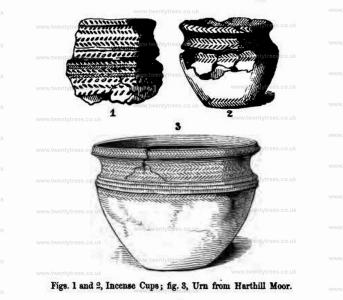
Throwley. On the 10th of February, we investigated a tumulus [Possibly Cart Low [Map]] midway between Throwley and Calton, 17 yards across and 3 feet high, wholly composed of earth of a burnt appearance throughout The principal interment was found about a yard from the centre, and consisted of a deposit of large pieces of calcined human bone, which lay within a circular hole in the natural soil, about a foot deep, of well defined shape, resulting from contact with a wooden or wicker work vessel, in which the bones were placed when buried, the vestiges of which, in the form of impalpable black powder, intervened between the bones and the earth. Upon the bones lay part of a small bronze pin, and a very beautiful miniature vase, of the "Incense Cup" type, 8⅛ inches high, 3½ diameter, ornamented with chevrons and lozenges, and perforated in two places at one side. Among the bones were two small pointed pieces of flint, and a common quartz pebble; and below the deposit was the shoulder-blade of a large animal, which has been designedly reduced to an irregular shape by the use of flint saws, or otlier instruments equally inefficient. At one side of this interment, were four other deposits of calcined bone, placed on the floor of the mound, here of rock, intersected by veins of clay, without any protection from cist or urn, but evidently deposited at one and the same time, as the heaps were quite distinct and imdisturbed, though very near to each other. They had been so thoroughly calcined as to be comminuted, and had almost reached the inevitable catastrophe of "dust to dust,"
Blore. 2nd June, we opened a barrow [Net Low Barrow [Map]] near Blore, In a field called Nettles (Net Lows?) formed around a natural elevation, which is only slightly covered at the top; the entire diameter is 13 yards. On the S.W. side we found a cist, the outer side formed of a long stone placed on edge, the inner being walled from the surface to the bottom, which was paved with flat stones; the depth was 2 feet. On the floor was a deposit of calcined bones, and in a corner was a broken urn of red clay, containing a small vase, or "incense cup," in better preservation.
The large vase, originally about 9 inches high by 5 diameter, is of clay, plentifully mixed with sand and imperfectly baked, whence the surface is much disintegrated. It has been of good form and workmanship, having a deep border ornamented with diagonal lines disposed in triangles in alternate directions. The cup is of similar clay, 2½ inches high, 3 inches across the mouth, and quite plain. Nearer the edge, on the same side of the barrow, we found some remains of an unburnt skeleton, which had been previously disturbed, and not far from it were two articles indicating the interment to have been of late period; namely, the bottom of a kiln-baked vessel of blue clay, showing marks of having been turned on the potter's wheel, and a small iron ring 1¼ inch in diameter. Fragments of bone, burnt and unburnt, rats' bones, teeth of oxen, and pebbles were found throughout the cuttings.
Middleton. On the 24th of October, we opened a large trench in the barrow [Larks Low Barrow [Map]] at Larkslow, near Middleton by Youlgrave, which was first examined by Mr. William Bateman, in 1825, when amongst other things were found a cinerary urn, containing burnt bones, and an "incense cup." It appeared by our excavation, that the centre of the barrow had been surrounded by large masses of chert, within which circle the interment had been deposited. We discovered the calcined bones which had been emptied out of the urn at the former opening, and a few pieces of an unburnt skeleton. From a very careful examination of the former, we find them to consist of the remains of a full-grown person, and an infant, with whom had been calcined a few small instruments of flint, a bone pin, and a tooth of some large animal. It is probable that the critical examination of all deposits of burnt bones would lead to much curious information respecting the statistics of suttee, and infanticide, both which abominations we are unwillingly compelled, by accumulated evidence to believe were practised in Pagan Britain.
Stanton. On the 10th of April, 1852, in company with Mr. Carrington, and Mr. Glover, the Historian of the County of Derby, I walked over a considerable part of Stanton Moor, in order to survey the scene of former discoveries, and to examine the existing remains of Tumuli, Rocking Stones, &c., upon this interesting tract of land. On passing over the brow of the hill, near the Andle Stone [Map], we noticed a small circle [Doll Tor [Map]] of six stones, four of which retained their upright position, whilst two were prostrate, the diameter being about twenty feet; in the interior were a few small pieces of pottery, and some calcined bones that had been scratched up by rabbits, the sight of which caused us to set to work with our pocket-knives, when finding the remains to become more plentiful, we borrowed a hack and spade from the adjoining farm, and cleared a considerable space in the centre of the enclosure, where a grave had been dug for the reception of three or four cinerary urns, and as many "incense cups;" all which had been emptied of their calcined contents, and broken by former diggers, who, however, left the fragments. These having since been joined, as far as possible, afford a tolerable idea of the original shape and ornamentation of the vessels, about which there is a little peculiarity, the outline of the large urns being more straight sided than common in this part of England; they approach the form of a common red garden flower-pot, and are sparingly decorated with the everlasting chevron. Most of the urns of this type hitherto discovered, have been exhumed in the South-West of England, the Deverell Barrow having afforded several specimens.
Wiltshire Archaeological Magazine 1907 V35 Pages 1-20. No. 15. This small rude cup-like vase should perhaps be classed as belonging to the type known as "incense cups". It is decorated with a series of small oblong punctures in would-be vertical rows, the rows are fairly straight at first, but the artist seems soon to have got into difficulties, and the lines become increasingly slanting until they are at such an angle that they never reach the bottom at all, and are allowed half-way down the side to merge into the other lines. The more perfect portion of the rim is J of an inch in width, and has been decorated with a chevron pattern of lines drawn from edge to edge; the triangular spaces between the lines have punctured dots in them, and these dots and lines appear to have been filled in with some white stuff as if for the purpose of making the pattern stand out more clearly. Canon Greenwell (age 86) mentions a somewhat similar case, where a pattern seems to have been emphasised by means of a white substance filling in the lines on an incense cup from a barrow at Aldbourne, Wilts1. One half of the cup is much more crumbly and decayed than the other; from this part the white filling is absent and the edges are blackened as if it had been in a fire, and more affected by it on one side than the other. It would seem that the crudeness of the ornamentation could only have been the result of sheer carelessness, or of an intelligence and skill equal to that of a child.
Archæogia, LII., p. 53. The same peculiarity may be seen on a drinking cup from Roundway Down, in the Museum at Devizes.
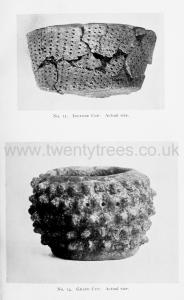
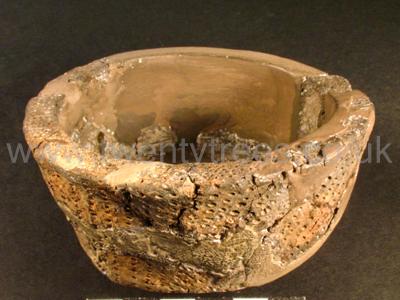 Miniature (incense) cup with vertical and diagonal lines of impressed dots around body, and forming zig-zags around rim. Collection of [Map].
Miniature (incense) cup with vertical and diagonal lines of impressed dots around body, and forming zig-zags around rim. Collection of [Map].
Wiltshire Archaeological Magazine 1907 V35 Pages 1-20. The Grape Cup was found behind the neck within a few inches of the shoulders - so close, indeed, that some of the vertebrae had to be disturljed before it could be removed with safety. It was lying on its side tilted towards the skeleton; it had, however, probably been placed in an upright position, and only tilted forward as the bones collapsed.
Wiltshire Archaeological Magazine 1907 V35 Pages 1-20. The incense cup was also at the back of the skeleton; it was 1ft. to 1½ft. behind the Grape Cup on a slightly higher level, and apparently must have been placed there after the body had been at least partially buried.
Wiltshire Archaeological Magazine 1907 V35 Pages 1-20. Previous to this discovery there seem to have been only six recorded finds of Grape Cups1. They were so named by Sir R. Colt Hoare, and re-named "nodulated cups" by Dr. Thurnam2, who included among their number a small rude cup, now in the Museum at Devizes3, which though nodulated, can by no stretch of the imagination be classed as a Grape Cup. Four of these cups are in the Museum at Devizes, one is in the Bristol Museum, and one has been lost sight of. With the exception of the one at Bristol that was found in a barrow at Priddy, in the neighbouring county of Somerset, they have all been found in Wiltshire barrows.
Upton Lovel Golden Barrow, with burnt interment. Ancient Wilts, p. 99, at Devizes; Amesbury, barrow 133, burnt, ibid, p. 199, at Devizes; Normanton, barrow 156, unburnt, ibid, p. 202, at Devizes. Barrow on Windmill Hill, near Avebury, see Rev. A. C. Smith's Map, Section VI., F. IV.b., unburnt interment; Arch. Instit., Salisbury, p. 108. at Devizes. Barrow south-east of Kennet, unburnt interment, LOST. Diary of a Dean, p. 44 [02 Aug], fig. 2. Barrow near Priddy, burnt interment, at Bristol Museum, Arch. Journ., XVI., p. 149. Of the seven grape cups now known it will be seen that three were with burnt and four with unburnt burials.
Note 2. Archœologia, XLIII., p. 364.
Note 3. Stourhead Cat., No. 187.
Wiltshire Archaeological Magazine 1907 V35 Pages 1-20. It is worthy of note that, while only seven Grape Cups are known to have been found, and only eight Wiltshire barrows have contained gold, in three cases the Grape Cup and the gold were found associated in the same barrow1.
Note 1. Ancient Wilts, barrows Nos. 40 and 156, and at Manton.
Wiltshire Museum. DZSWS:STHEAD.69a. 1 saucer-shaped incense cup (broken) decorated with three lines of impressed cord around its with broad flat rim, found with a primary cremation in Bowl barrow Winterbourne Stoke G64b [Map], excavated by William Cunnington.
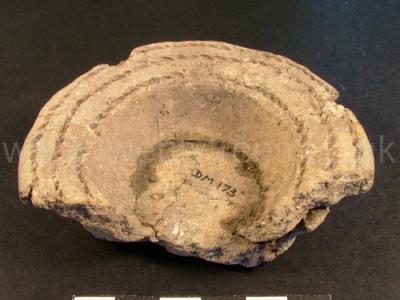
Wiltshire Museum. DZSWS:STHEAD.70b. 1 rough bowl-shaped incense cup decorated with irregular squares of impressed dots around one side and smaller squares, crosses and other shapes around the other (the thick rim also has lines of impressed dots around it) found with a primary cremation under an inverted MBA urn in disc barrow Winterbourne Stoke G68 [Map], excavated by William Cunnington.
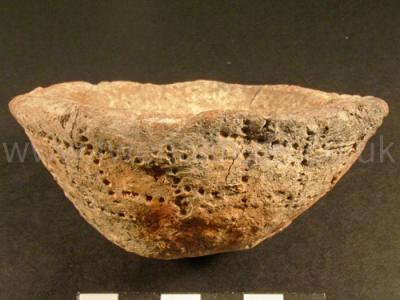
Wiltshire Museum. DZSWS:STHEAD.79a. 1 Aldbourne incense cup with vertical lines of dots between two pairs parallel lines of impressed cord on the outside (the lower half containing diagonal hatchings of cord and two perforations) and a wide flared rim decorated with zigzags between two pairs of parallel impressed cord lines on the inside found with a primary (?) cremation in Bowl barrow Winterbourne Stoke G16a [Map], excavated by William Cunnington.
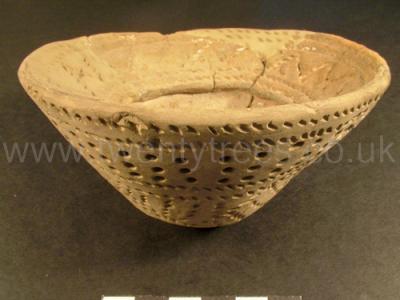
Wiltshire Museum. DZSWS:STHEAD.187. 1 incense or 'grape cup' of rough yellow ware (broken) with nodules around the lower half and some perforations between them, found with a primary inhumation in bowl barrow Winterbourne Stoke G8 [Map], excavated by William Cunnington.
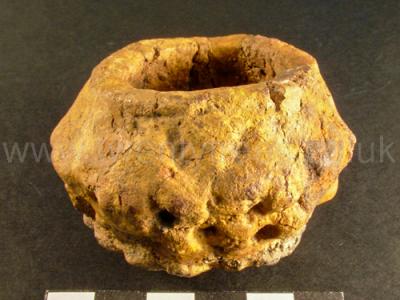
Wiltshire Museum. DZSWS:STHEAD.334. 1 miniature cup (incense cup?) in fragments with triangle patterns made with impressed dots found with a primary skeleton placed in a boat-shaped coffin in bowl barrow Winterbourne Stoke G9, excavated by William Cunnington.
